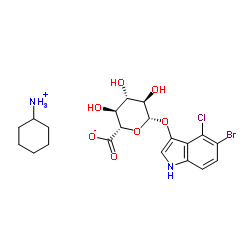114162-64-0
| Name | 5-bromo-4-chloro-3-indolyl b-d |
|---|---|
| Synonyms |
X-Gluc CHA Salt
5-Bromo-4-chloro-3-indolyl-β-D-glucuronic acid cyclohexylammonium salt 5-Bromo-4-chloro-3-indolyl β-D-glucuronide cyclohexylammonium salt 5-Bromo-4-chloro-3-indolyl Beta-D-glucuronide cyclohexylammonium salt 5-Bromo-4-chloro-3-indolyl-beta-D-glucuronide cyclohexylammonium salt hydrate Cyclohexanaminium 5-bromo-4-chloro-1H-indol-3-yl β-D-glucopyranosiduronate X-glucuronide CHA salt X-gluc/X-GlcA X-Glu,CHA Salt 5-Bromo-4-chlo X-GlcA CHA Salt β-D-Glucopyranosiduronic acid, 5-bromo-4-chloro-1H-indol-3-yl, compd. with cyclohexanamine (1:1) Cyclohexanamine - 5-bromo-4-chloro-1H-indol-3-yl β-D-glucopyranosiduronic acid (1:1) 5-Bromo-4-chloro-3-indolyl-β-D-glucuronide cyclohexylammonium salt X-GlcA,X-glucuronide CHA salt 5-BROMO-4-CHLORO-3-INDOLYLB-D-GLUCURONID E 5-Bromo-4-chloro-3-indolyl β-D-Glucopyranosiduronic Acid Cyclohexylammonium Salt 5-BROMO-4-CHLORO-3-INDOLYL-B-D-GLUCURO-N IDE CYCLOHEXYLA.S. |
| Description | X-Gluc cyclohexanamine is a dye reagent for the detection of β-glucuronidase (GUS), an enzyme produced by E. coli. X-Gluc cyclohexanamine can be used to detect E. coli contamination in food, water and the urinary tract (GUS as a specific detection indicator). X-Gluc cyclohexanamine is also widely used in molecular biology experiments to label and detect the expression of target genes (reacts with the GUS gene, appears blue)[1]. |
|---|---|
| Related Catalog | |
| In Vitro | Guidelines (Following is our recommended protocol. This protocol only provides a guideline, and should be modified according to your specific needs). 1. Dissolve 20 mg X-Gluc cyclohexanamine in 1mL dimethylformamide (DMF) to prepare X-Gluc master mix. 2. Add the prepared X-Gluc solution to agar medium plates at a final concentration of 50 μg/mL without sterilization. 3. Allow the plates to air dry and be used to inoculate the organisms. 4. Incubate the plates at 35°C and observe 16-24 h after inoculation. |
| References |
| Density | 1.4241 (rough estimate) |
|---|---|
| Boiling Point | 732.2ºC at 760 mmHg |
| Melting Point | 228-230ºC |
| Molecular Formula | C20H26BrClN2O7 |
| Molecular Weight | 521.787 |
| Flash Point | 396.6ºC |
| Exact Mass | 520.061157 |
| PSA | 158.26000 |
| LogP | 2.83290 |
| Vapour Pressure | 1.66E-22mmHg at 25°C |
| Index of Refraction | 1.6110 (estimate) |
| Storage condition | 2-8°C |
| Water Solubility | DMF: soluble |
| Personal Protective Equipment | Eyeshields;Gloves;type N95 (US);type P1 (EN143) respirator filter |
|---|---|
| Hazard Codes | Xi: Irritant; |
| Risk Phrases | R36/37/38 |
| Safety Phrases | S26-S37/39 |
| RIDADR | NONH for all modes of transport |
| WGK Germany | 3 |
| HS Code | 29349990 |
